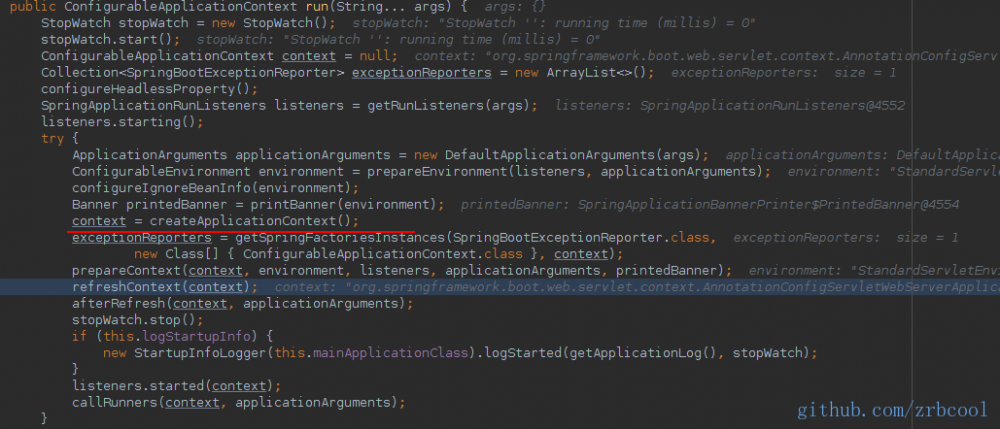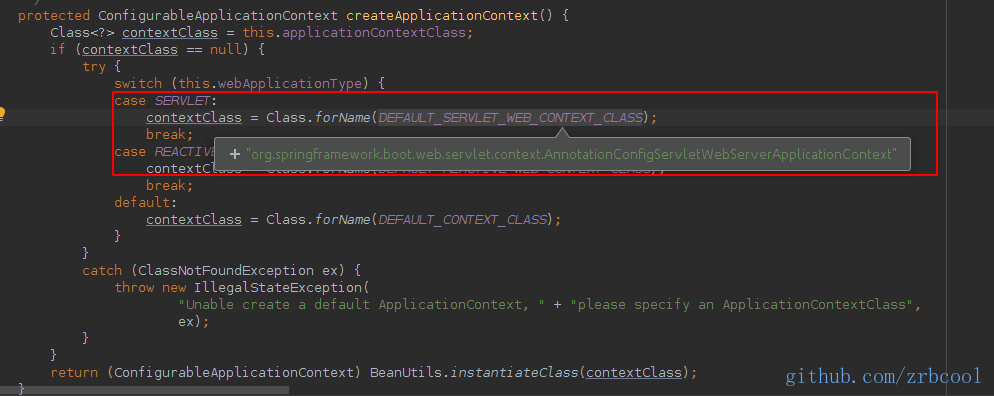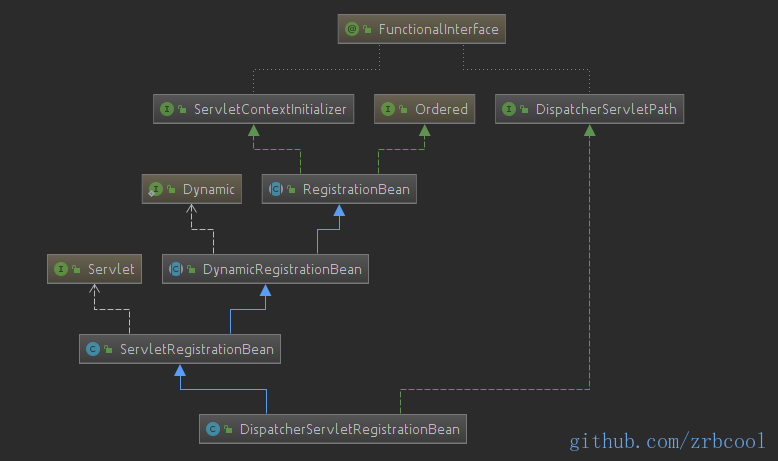Spring Boot与Spring MVC集成启动过程源码分析
Pepper Metrics 是我与同事开发的一个开源工具( github.com/zrbcool/pep… ),其通过收集jedis/mybatis/httpservlet/dubbo/motan的运行性能统计,并暴露成prometheus等主流时序数据库兼容数据,通过grafana展示趋势。其插件化的架构也非常方便使用者扩展并集成其他开源组件。
请大家给个star,同时欢迎大家成为开发者提交PR一起完善项目。
从一个最简单的Spring Boot Web项目聊起
我们知道,用spring-boot写一个web项目非常容易,pom继承spring-boot-parent然后引入依赖spring-boot-starter-web,再写一个这样的主启动类,然后就可以去写Controller了,十分简单,就像这样:
@SpringBootApplication
public class SampleApplication {
public static void main(String[] args) {
SpringApplication.run(SampleApplication.class, args);
}
}
// 然后再写一个Controller声明一个Rest服务
@RestController
@RequestMapping("/perf")
public class PerfController {
@RequestMapping("/trace")
public Object trace() {
Object result = yourLogic();
return result;
}
}
复制代码
聊聊SpringApplication.run
可是我们思考过,这背后spring-boot到底做了什么使我们的工作如此简单,它如何将spring、spring-mvc、tomcat整合到一起的呢?接下来我们以项目启动角度来分析整个初始化过程。
PS:下面代码分析过程中,着重于流程的串接,调用到某个变量时,作者会直接给出这个变量的具体实现,读者也许会产生困惑,但是不要停下来,先想当然的按照作者的思路把流程捋完,后面会针对各个主要的变量初始化及选择实现的过程进行逐个解释。
从SpringApplication.run说起: 方法定义如下
public static ConfigurableApplicationContext run(Class<?>[] primarySources, String[] args) {
return new SpringApplication(primarySources).run(args);
}
public ConfigurableApplicationContext run(String... args) {
StopWatch stopWatch = new StopWatch();
stopWatch.start();
ConfigurableApplicationContext context = null;
Collection<SpringBootExceptionReporter> exceptionReporters = new ArrayList<>();
configureHeadlessProperty();
SpringApplicationRunListeners listeners = getRunListeners(args);
listeners.starting();
try {
ApplicationArguments applicationArguments = new DefaultApplicationArguments(args);
ConfigurableEnvironment environment = prepareEnvironment(listeners, applicationArguments);
configureIgnoreBeanInfo(environment);
Banner printedBanner = printBanner(environment);
context = createApplicationContext();//1)
exceptionReporters = getSpringFactoriesInstances(SpringBootExceptionReporter.class,
new Class[] { ConfigurableApplicationContext.class }, context);
prepareContext(context, environment, listeners, applicationArguments, printedBanner);
refreshContext(context);//2)
afterRefresh(context, applicationArguments);
stopWatch.stop();
if (this.logStartupInfo) {
new StartupInfoLogger(this.mainApplicationClass).logStarted(getApplicationLog(), stopWatch);
}
listeners.started(context);
callRunners(context, applicationArguments);
}
catch (Throwable ex) {
handleRunFailure(context, ex, exceptionReporters, listeners);
throw new IllegalStateException(ex);
}
try {
listeners.running(context);
}
catch (Throwable ex) {
handleRunFailure(context, ex, exceptionReporters, null);
throw new IllegalStateException(ex);
}
return context;
}
复制代码
我们来分解下这个run方法
先看1)context = createApplicationContext()
负责创建spring主容器,这个方法内部是根据具体项目运行时依赖的类来动态选择实现的,如果是web项目则会选择AnnotationConfigServletWebServerApplicationContext,至于选择的规则及原因,这里先忽略,后面会专门介绍(时空门:ServletWebServerApplicationContext)。
接下来我们重点看2)refreshContext(context)方法
其方法内部最终调用了((AbstractApplicationContext) applicationContext).refresh()方法,我们把这个方法展开
@Override
public void refresh() throws BeansException, IllegalStateException {
synchronized (this.startupShutdownMonitor) {
prepareRefresh();
ConfigurableListableBeanFactory beanFactory = obtainFreshBeanFactory();
prepareBeanFactory(beanFactory);
try {
postProcessBeanFactory(beanFactory);
invokeBeanFactoryPostProcessors(beanFactory);
registerBeanPostProcessors(beanFactory);
initMessageSource();
initApplicationEventMulticaster();
onRefresh();//3)
registerListeners();
finishBeanFactoryInitialization(beanFactory);
finishRefresh();
}
catch (BeansException ex) {
if (logger.isWarnEnabled()) {
logger.warn("Exception encountered during context initialization - " +
"cancelling refresh attempt: " + ex);
}
destroyBeans();
cancelRefresh(ex);
throw ex;
}
finally {
resetCommonCaches();
}
}
}
复制代码
实际上,这里我们的调用已经到了spring-context包,其实跟spring-boot已经没啥关系了,这其实就是一个标准的SpringApplicationContext的标准启动过程中refresh()部分,我们不是对spring启动过程分解,所以我们只关注与tomcat,spring-mvc结合的部分。
直接看3)onRefresh()方法,因为AnnotationConfigServletWebServerApplicationContext是ServletWebServerApplicationContext的子类,所以流程进入ServletWebServerApplicationContext的onRefresh()方法
@Override
protected void onRefresh() {
super.onRefresh();
try {
createWebServer();//4)
}
catch (Throwable ex) {
throw new ApplicationContextException("Unable to start web server", ex);
}
}
复制代码
可以看到这个4)createWebServer(),是我们的关键
private void createWebServer() {
WebServer webServer = this.webServer;
ServletContext servletContext = getServletContext();
if (webServer == null && servletContext == null) {
ServletWebServerFactory factory = getWebServerFactory();//5)
this.webServer = factory.getWebServer(getSelfInitializer());//6)
}
else if (servletContext != null) {
try {
getSelfInitializer().onStartup(servletContext);
}
catch (ServletException ex) {
throw new ApplicationContextException("Cannot initialize servlet context", ex);
}
}
initPropertySources();
}
复制代码
其中:
5)ServletWebServerFactory factory = getWebServerFactory();
上面这句获取到的具体实现是TomcatServletWebServerFactory(时空门:TomcatServletWebServerFactory) 6)this.webServer = factory.getWebServer(getSelfInitializer());
先看6)中的getSelfInitializer()方法:
private org.springframework.boot.web.servlet.ServletContextInitializer getSelfInitializer() {
return this::selfInitialize;
}
private void selfInitialize(ServletContext servletContext) throws ServletException {
prepareWebApplicationContext(servletContext);
registerApplicationScope(servletContext);
WebApplicationContextUtils.registerEnvironmentBeans(getBeanFactory(), servletContext);
for (ServletContextInitializer beans : getServletContextInitializerBeans()) {
beans.onStartup(servletContext);
}
}
复制代码
这块有点意思,返回的是一个this::selfInitialize,方法定义是返回org.springframework.boot.web.servlet.ServletContextInitializer,我们看下它是什么定义
@FunctionalInterface
public interface ServletContextInitializer {
void onStartup(ServletContext servletContext) throws ServletException;
}
复制代码
@FunctionalInterface是java8中lambda支持的一种函数式接口selfInitialize这段逻辑在后面过程当中会被调用。
继续看6)中this.webServer = factory.getWebServer(...),我们看下实现:
@Override
public WebServer getWebServer(ServletContextInitializer... initializers) {
Tomcat tomcat = new Tomcat();
File baseDir = (this.baseDirectory != null) ? this.baseDirectory : createTempDir("tomcat");
tomcat.setBaseDir(baseDir.getAbsolutePath());
Connector connector = new Connector(this.protocol);
tomcat.getService().addConnector(connector);
customizeConnector(connector);
tomcat.setConnector(connector);
tomcat.getHost().setAutoDeploy(false);
configureEngine(tomcat.getEngine());
for (Connector additionalConnector : this.additionalTomcatConnectors) {
tomcat.getService().addConnector(additionalConnector);
}
prepareContext(tomcat.getHost(), initializers);//7)
return getTomcatWebServer(tomcat);
}
复制代码
可以看到在里面创建了Tomcat实例作为webServer的内部实现,然后向Tomcat的Service容器注入Connector,然后设置默认Host容器的AutoDeploy属性及其他的Tomcat初始化工作,最重要的一行是7)
我们来看一下:
protected void prepareContext(Host host, ServletContextInitializer[] initializers) {
File documentRoot = getValidDocumentRoot();
TomcatEmbeddedContext context = new TomcatEmbeddedContext();
if (documentRoot != null) {
context.setResources(new LoaderHidingResourceRoot(context));
}
...//省略我们不关注的部分代码
ServletContextInitializer[] initializersToUse = mergeInitializers(initializers);//8)
host.addChild(context);//将context加入host作为host的子容器
configureContext(context, initializersToUse);//9)
postProcessContext(context);
}
复制代码
我们可以看到其调用host.addChild(context)将context加入host作为host的子容器,然后 其中8)查找所有ServletContextInitializer实现并合并为一个数组,然后调用9)configureContext方法,我们来看一下:
protected void configureContext(Context context, ServletContextInitializer[] initializers) {
TomcatStarter starter = new TomcatStarter(initializers);//10)
if (context instanceof TomcatEmbeddedContext) {
TomcatEmbeddedContext embeddedContext = (TomcatEmbeddedContext) context;
embeddedContext.setStarter(starter);
embeddedContext.setFailCtxIfServletStartFails(true);
}
context.addServletContainerInitializer(starter, NO_CLASSES);//11)
...//忽略
}
复制代码
10)创建了TomcatStarter对象,并将starter加入context的conainerInitializer列表,见11),这样在tomcat的容器启动过程中就会调用到这个TomcatStarter实例。
我们来看下TomcatStarter做了什么
class TomcatStarter implements ServletContainerInitializer {
...
private final ServletContextInitializer[] initializers;
...
TomcatStarter(ServletContextInitializer[] initializers) {
this.initializers = initializers;
}
...
@Override
public void onStartup(Set<Class<?>> classes, ServletContext servletContext) throws ServletException {
try {
for (ServletContextInitializer initializer : this.initializers) {
initializer.onStartup(servletContext);
}
}
catch (Exception ex) {
this.startUpException = ex;
if (logger.isErrorEnabled()) {
logger.error("Error starting Tomcat context. Exception: " + ex.getClass().getName() + ". Message: "
+ ex.getMessage());
}
}
}
...
}
复制代码
可以看到TomcatStarter相当于hook了context启动的事件,然后调用所有注入的initializers的onStartup方法,似曾相识是吗?这就是前面说的@FunctionalInterface函数接口,接下来我们就深入看下前面提到的那个initializer的onStartup的具体内容
//ServletWebServerApplicationContext类当中
private org.springframework.boot.web.servlet.ServletContextInitializer getSelfInitializer() {
return this::selfInitialize;
}
private void selfInitialize(ServletContext servletContext) throws ServletException {
prepareWebApplicationContext(servletContext);
registerApplicationScope(servletContext);
WebApplicationContextUtils.registerEnvironmentBeans(getBeanFactory(), servletContext);
for (ServletContextInitializer beans : getServletContextInitializerBeans()) {
beans.onStartup(servletContext);
}
}
复制代码
可以看到其对getServletContextInitializerBeans()的每个ServletContextInitializer均调用了onStartup方法
protected Collection<ServletContextInitializer> getServletContextInitializerBeans() {
return new ServletContextInitializerBeans(getBeanFactory());
}
复制代码
看看new ServletContextInitializerBeans(getBeanFactory())做了什么
@SafeVarargs
public ServletContextInitializerBeans(ListableBeanFactory beanFactory,
Class<? extends ServletContextInitializer>... initializerTypes) {
this.initializers = new LinkedMultiValueMap<>();
this.initializerTypes = (initializerTypes.length != 0) ? Arrays.asList(initializerTypes)
: Collections.singletonList(ServletContextInitializer.class);
addServletContextInitializerBeans(beanFactory);
addAdaptableBeans(beanFactory);
List<ServletContextInitializer> sortedInitializers = this.initializers.values().stream()
.flatMap((value) -> value.stream().sorted(AnnotationAwareOrderComparator.INSTANCE))
.collect(Collectors.toList());
this.sortedList = Collections.unmodifiableList(sortedInitializers);
logMappings(this.initializers);
}
复制代码
可以看到其从beanFactory中获取spring容器中所有的ServletContextInitializer实现,这里关于集成的部分在ServletRegistrationBean中,ServletRegistrationBean的注入过程参考:时空门:Dispatcherservletregistrationbean
private void addServletContextInitializerBeans(ListableBeanFactory beanFactory) {
for (Class<? extends ServletContextInitializer> initializerType : this.initializerTypes) {
for (Entry<String, ? extends ServletContextInitializer> initializerBean : getOrderedBeansOfType(beanFactory,
initializerType)) {
addServletContextInitializerBean(initializerBean.getKey(), initializerBean.getValue(), beanFactory);
}
}
}
private void addServletContextInitializerBean(String beanName, ServletContextInitializer initializer,
ListableBeanFactory beanFactory) {
if (initializer instanceof ServletRegistrationBean) {
Servlet source = ((ServletRegistrationBean<?>) initializer).getServlet();
addServletContextInitializerBean(Servlet.class, beanName, initializer, beanFactory, source);
}
else if (initializer instanceof FilterRegistrationBean) {
Filter source = ((FilterRegistrationBean<?>) initializer).getFilter();
addServletContextInitializerBean(Filter.class, beanName, initializer, beanFactory, source);
}
else if (initializer instanceof DelegatingFilterProxyRegistrationBean) {
String source = ((DelegatingFilterProxyRegistrationBean) initializer).getTargetBeanName();
addServletContextInitializerBean(Filter.class, beanName, initializer, beanFactory, source);
}
else if (initializer instanceof ServletListenerRegistrationBean) {
EventListener source = ((ServletListenerRegistrationBean<?>) initializer).getListener();
addServletContextInitializerBean(EventListener.class, beanName, initializer, beanFactory, source);
}
else {
addServletContextInitializerBean(ServletContextInitializer.class, beanName, initializer, beanFactory,
initializer);
}
}
复制代码
然后流程就顺了,我们会调用到ServletRegistrationBean的onStartup方法,最终会调用到servletContext.addServlet的Servlet3.0的标准将DispatchServlet注入到servlet容器中拦截所有的请求。
见下面代码:
//RegistrationBean
@Override
public final void onStartup(ServletContext servletContext) throws ServletException {
String description = getDescription();
if (!isEnabled()) {
logger.info(StringUtils.capitalize(description) + " was not registered (disabled)");
return;
}
register(description, servletContext);
}
//DynamicRegistrationBean
@Override
protected final void register(String description, ServletContext servletContext) {
D registration = addRegistration(description, servletContext);
if (registration == null) {
logger.info(
StringUtils.capitalize(description) + " was not registered " + "(possibly already registered?)");
return;
}
configure(registration);
}
//ServletRegistrationBean
@Override
protected ServletRegistration.Dynamic addRegistration(String description, ServletContext servletContext) {
String name = getServletName();
return servletContext.addServlet(name, this.servlet);
}
复制代码
至此所有集成完毕,启动过程交给tomcat完成。
没讲完的故事:各个依赖的组件是如何初始化的
TomcatServletWebServerFactory
spring-boot-autoconfigure/META-INF/spring.factories中有一段配置:
... # Auto Configure org.springframework.boot.autoconfigure.EnableAutoConfiguration=/ org.springframework.boot.autoconfigure.web.servlet.ServletWebServerFactoryAutoConfiguration,/ ... 复制代码
然后我们来看下ServletWebServerFactoryAutoConfiguration类
@Configuration
@AutoConfigureOrder(Ordered.HIGHEST_PRECEDENCE)
@ConditionalOnClass(ServletRequest.class)
@ConditionalOnWebApplication(type = Type.SERVLET)
@EnableConfigurationProperties(ServerProperties.class)
@Import({ ServletWebServerFactoryAutoConfiguration.BeanPostProcessorsRegistrar.class,
ServletWebServerFactoryConfiguration.EmbeddedTomcat.class,
ServletWebServerFactoryConfiguration.EmbeddedJetty.class,
ServletWebServerFactoryConfiguration.EmbeddedUndertow.class })
public class ServletWebServerFactoryAutoConfiguration {
...
}
复制代码
其中@Import部分引入了ServletWebServerFactoryConfiguration.EmbeddedTomcat.class,深入看一下
@Configuration
class ServletWebServerFactoryConfiguration {
@Configuration
@ConditionalOnClass({ Servlet.class, Tomcat.class, UpgradeProtocol.class })
@ConditionalOnMissingBean(value = ServletWebServerFactory.class, search = SearchStrategy.CURRENT)
public static class EmbeddedTomcat {
@Bean
public TomcatServletWebServerFactory tomcatServletWebServerFactory() {
return new TomcatServletWebServerFactory();
}
}
...
}
复制代码
这块Spring Boot根据@ConditionalOnClass判断当前运行时环境是否符合条件,即包含了tomcat的jar包,如果满足则创建TomcatServletWebServerFactory的Bean实例加入spring容器管理,后面有用。
ServletWebServerApplicationContext
实际启动时,启动的是其子类AnnotationConfigServletWebServerApplicationContext,我们来看下SpringApplication类,实际上SpringApplication在运行时根据情况决定使用哪种ApplicationContext

查看createApplicationContext()方法

那么这个this.webApplicationType又是哪来的值呢? 我们看下这个构造方法
public SpringApplication(ResourceLoader resourceLoader, Class<?>... primarySources) {
this.resourceLoader = resourceLoader;
Assert.notNull(primarySources, "PrimarySources must not be null");
this.primarySources = new LinkedHashSet<>(Arrays.asList(primarySources));
this.webApplicationType = WebApplicationType.deduceFromClasspath();
setInitializers((Collection) getSpringFactoriesInstances(ApplicationContextInitializer.class));
setListeners((Collection) getSpringFactoriesInstances(ApplicationListener.class));
this.mainApplicationClass = deduceMainApplicationClass();
}
复制代码
WebApplicationType.deduceFromClasspath()用来自动识别这个值,看下实现:
static WebApplicationType deduceFromClasspath() {
if (ClassUtils.isPresent(WEBFLUX_INDICATOR_CLASS, null) && !ClassUtils.isPresent(WEBMVC_INDICATOR_CLASS, null)
&& !ClassUtils.isPresent(JERSEY_INDICATOR_CLASS, null)) {
return WebApplicationType.REACTIVE;
}
for (String className : SERVLET_INDICATOR_CLASSES) {
if (!ClassUtils.isPresent(className, null)) {
return WebApplicationType.NONE;
}
}
return WebApplicationType.SERVLET;
}
复制代码
可以看到它是通过判断classloader中是否有Servlet相关的class来判断的,所以是运行时判断的。
DispatcherServletRegistrationBean
DispatcherServletRegistrationBean是保证我们的DispatcherServlet被注入到Servlet容器并生效的关键,我们来看下它是如何初始化的
spring-boot-autoconfigure/META-INF/spring.factories中有一段配置:
# Auto Configure org.springframework.boot.autoconfigure.EnableAutoConfiguration=/ org.springframework.boot.autoconfigure.web.servlet.DispatcherServletAutoConfiguration,/ 复制代码
看看实现
@AutoConfigureOrder(Ordered.HIGHEST_PRECEDENCE)
@Configuration
@ConditionalOnWebApplication(type = Type.SERVLET)
@ConditionalOnClass(DispatcherServlet.class)
@AutoConfigureAfter(ServletWebServerFactoryAutoConfiguration.class)
public class DispatcherServletAutoConfiguration {
@Configuration
@Conditional(DispatcherServletRegistrationCondition.class)
@ConditionalOnClass(ServletRegistration.class)
@EnableConfigurationProperties(WebMvcProperties.class)
@Import(DispatcherServletConfiguration.class)
protected static class DispatcherServletRegistrationConfiguration {
private final WebMvcProperties webMvcProperties;
private final MultipartConfigElement multipartConfig;
public DispatcherServletRegistrationConfiguration(WebMvcProperties webMvcProperties,
ObjectProvider<MultipartConfigElement> multipartConfigProvider) {
this.webMvcProperties = webMvcProperties;
this.multipartConfig = multipartConfigProvider.getIfAvailable();
}
@Bean(name = DEFAULT_DISPATCHER_SERVLET_REGISTRATION_BEAN_NAME)
@ConditionalOnBean(value = DispatcherServlet.class, name = DEFAULT_DISPATCHER_SERVLET_BEAN_NAME)
public DispatcherServletRegistrationBean dispatcherServletRegistration(DispatcherServlet dispatcherServlet) {
DispatcherServletRegistrationBean registration = new DispatcherServletRegistrationBean(dispatcherServlet,
this.webMvcProperties.getServlet().getPath());
registration.setName(DEFAULT_DISPATCHER_SERVLET_BEAN_NAME);
registration.setLoadOnStartup(this.webMvcProperties.getServlet().getLoadOnStartup());
if (this.multipartConfig != null) {
registration.setMultipartConfig(this.multipartConfig);
}
return registration;
}
}
}
复制代码
可以看到,其像spring容器注册了DispatcherServletRegistrationBean的Bean实例,看一下它的继承关系:

其父类ServletRegistrationBean类有如下方法:
@Override
protected ServletRegistration.Dynamic addRegistration(String description, ServletContext servletContext) {
String name = getServletName();
return servletContext.addServlet(name, this.servlet);
}
复制代码
其调用了ServletContext.addServlet方法将DispatchServlet加入到Servlet容器,这是Servlet3.0中注册servlet的方法。
那么你也许会问,addRegistration又是什么时机调用的呢? 根据继承关系,查看其父类的父类RegistrationBean,其有一个
@Override
public final void onStartup(ServletContext servletContext) throws ServletException {
String description = getDescription();
if (!isEnabled()) {
logger.info(StringUtils.capitalize(description) + " was not registered (disabled)");
return;
}
register(description, servletContext);
}
复制代码
register方法是一个模板方法,调用子类DynamicRegistrationBean的实现
@Override
protected final void register(String description, ServletContext servletContext) {
D registration = addRegistration(description, servletContext);
if (registration == null) {
logger.info(StringUtils.capitalize(description) + " was not registered " + "(possibly already registered?)");
return;
}
configure(registration);
}
复制代码
addRegistration方法又是一个模板方法,实现就是前面ServletRegistrationBean的addRegistration实现,而onStartup方法会在SpringApplication.run()方法的流程中被调用到,讲主流程的时候已经讲到,这里不再赘述
这样就将DispatchServlet与Tomcat进行了集成,DispatchServlet使用模板方法设计模式,将具体的请求分配给不同的handler处理,这个后面会讲到,本篇就主要专注在Spring Boot与Spring MVC及Tomcat的集成原理部分。
- 本文标签: 设计模式 springboot spring list HashSet db tar src IDE cache Document 构造方法 ssl 开发 servlet map Listeners 代码 Spring Boot value stream tab https provider 数据 bean App ArrayList root mybatis cat ACE GitHub id key lambda 源码 git dubbo 开发者 Service CTO EnableAutoConfiguration web REST jetty 数据库 http API Collection Collections Proxy classpath ip 开源 UI Property CEO 专注 java 插件 tk pom description 统计 管理 IO 实例 synchronized 启动过程 final tomcat 配置 message
- 版权声明: 本文为互联网转载文章,出处已在文章中说明(部分除外)。如果侵权,请联系本站长删除,谢谢。
- 本文海报: 生成海报一 生成海报二











![[HBLOG]公众号](https://www.liuhaihua.cn/img/qrcode_gzh.jpg)

